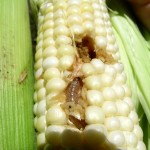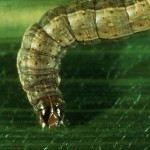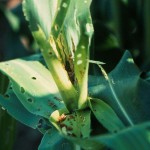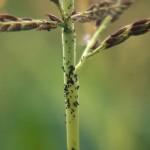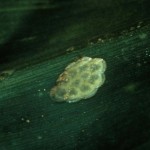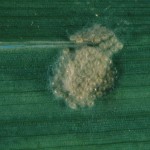For help with scouting please view the scouting video and use this scouting form.
Tassel emergence to silking
Fields should be first scouted, for European corn borer (ECB) and fall armyworm (FAW) larvae, at early tassel emergence. Even at a location with high ECB populations, insecticide applications in bare ground fields to whorl stage corn do not result in improved control when compared with one or two well-timed applications at tassel emergence. Larvae feeding in the whorl are protected from insecticide applications and mortality will not be as high as at tassel emergence, when larvae feeding in the emerging tassel are exposed to the spray. Larvae will leave the tassel as it opens up and no longer provides a moist, protected feeding environment, and move down the plant looking for protected places to feed. Insecticide applications need to be timed to kill larvae before they bore into a new feeding location where again they will be protected from sprays. In fields with very uneven development, two applications may be necessary, one when approximately 25-50% of the tassels have emerged, and again after 75-100% of the tassels have emerged, if the field is still over threshold.
The threshold for ECB and armyworms at tassel emergence is 15% infested plants. For corn borers, look down into emerging tassels for tiny larvae or frass (white to brown material about the size of fine sand). For armyworms look for ragged feeding holes and frass pellets the texture of coarse sawdust. This is also a good time to look for corn leaf aphids, record the number of plants with more than 20 aphids.
Scouting before your first insecticide application is fast and easy since any sign of feeding is a sure sign of live larvae, you therefore do not need to spend time finding the larvae. After the initial insecticide application, feeding damage may be from a larva that has already been killed, so finding the critter is more important for an accurate estimate of the number of infested plants.
The threshold for corn leaf aphid at tassel emergence is 50% of plants with more than 20 aphids.
Silking through one week before harvest:
Once a field is silking, the worm threshold drops to 5% infested plants. Scout the ear zone (roughly from two leaves above and one leaf below the ears) for ECB egg masses and ECB or FAW larvae. Egg masses are found most frequently on the underside of leaves near the midrib, and consist of approximately 10-20 flattened eggs overlapping like fish scales. Eggs are white when first laid, turning cream colored after a couple of days, and show the black head capsules of the tiny larvae through the surface of the eggs when within 1 day of hatching (the “black head” stage). Egg masses can also sometimes be found on the flag leaves of the ears or on the husk itself. Eggs take approximately 100 base 50 degree days to hatch. When temperatures are in the 70’s during the day and the 50’s at night egg masses will take about a week to hatch. When temperatures are in the 80’s during the day and the 60’s at night, they could hatch in only 4 days.
Look down into the tops of the silks for newly hatched larvae, and pull the ear away from the stalk slightly to look for larvae feeding between the stalk and the ear.
Corn earworm is difficult to scout for but pheromone trap catches may be used to time sprays according to the table below.
|
Average corn earwom catch |
|||
|
Per Day |
Per Five Days |
Per Week |
Days Between Sprays |
|
<0.2 |
<1.0 |
<1.4 |
No Spray(for CEW) |
|
0.2-0.5 |
1.0-2.5 |
1.4-3.5 |
6 days |
|
0.5-1.0 |
2.5-5.0 |
3.5-7.0 |
5 days |
|
1-13 |
5-65 |
7-91 |
4 days |
|
over 13 |
over 65 |
over 91 |
3 day |
Add one day to the recommended spray interval if daily maximum temperatures are less than 80° F for the previous 2-3 days.

